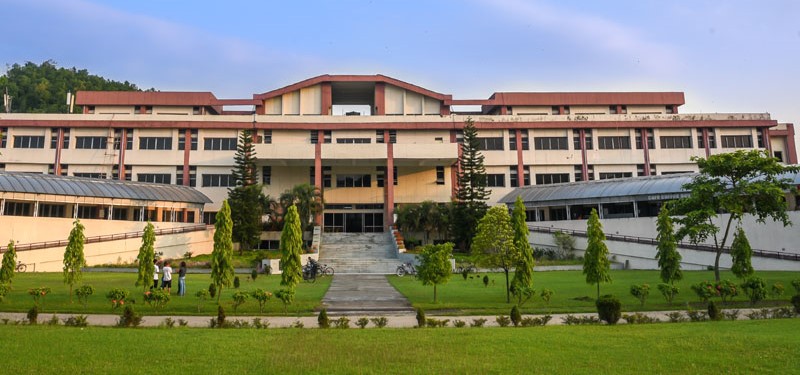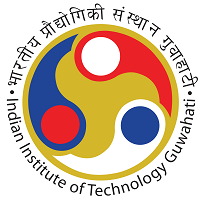
IIT Guwahati
Introduction
Indian Institute of Technology Guwahati, the sixth member of the IIT fraternity, was established in 1994. The academic programme of IIT Guwahati commenced in 1995. At present the Institute has eleven
departments, seven inter-disciplinary academic centres and five schools covering all the major engineering , science, healthcare, management and humanities disciplines, offering B.Tech., B.Des., M.A., M.Des.,
M.Tech., M.Sc., MBA and Ph.D. programmes. Within a short period of time, IIT Guwahati has been able to build up world class infrastructure for carrying out advanced research and has been equipped with state-of-the-art
scientific and engineering instruments. Besides its laurels in teaching and research, IIT Guwahati has been able to fulfil the aspirations of people of the North East region to a great extent since its inception
in 1994.
Indian Institute of Technology Guwahati's campus is on a sprawling 285 hectares plot of land on the north bank of the river Brahmaputra around 20 kms from the heart of the city. With
the majestic Brahmaputra on one side, and with hills and vast open spaces on others, the campus provides an ideal setting for learning.
IIT Guwahati is the only academic institution in India that occupied a place among the
top 100 world universities – under 50 years of age – ranked by the London-based Times Higher Education (THE) in the year 2014 and continues to maintain its superior position even today in various International
Rankings. IIT Guwahati gained rank 41 globally in the ‘Research Citations per Faculty’ category and overall 395 rank in the QS World University Rankings 2022 released recently. IIT Guwahati has retained the
7th position among the best engineering institutions of the country in the ‘India Rankings 2021’ declared by the National Institutional Ranking Framework (NIRF) of the Union Ministry of Education. IIT Guwahati
has been also ranked 2nd in the ‘Swachhata Ranking’ conducted by the Govt. of India. Recently, IIT Guwahati has been ranked as the top-ranked University in 2019 for IT developers by HackerRank in the
Asia-Pacific region.
History
The history of IIT Guwahati traces its roots to the 1985 Assam Accord signed between the All Assam Students Union and the Government of India, which mentions the general improvement in education facilities
in Assam and specifically the setting up of an IIT.
IIT Guwahati was established in 1994 by an act of parliament and its academic programme commenced in 1995. IIT Guwahati admitted its first batch
of students into its Bachelor of Technology programme in 1995. The selection process was the same as that of the other IITs, i.e., through the Joint Entrance Examination. In 1998, the first batch of students
was accepted into the Master of Technology program through the GATE.
Department
Placement
In the placement session 2021-22 (started from 1st December), a total of 180 companies from various sectors participated in the recruitment process. The total no. of students registered for campus placement in the year 2021-22 is 1243.
The overall placement of B.Tech and B.Des students is 88.51%. For B.Tech and B.Des, the number of total job offers so far is 578 (including PPO) out of 653 students.
The overall placement of M.Tech
and M.Des students is 66.66%. For M.Tech and M.Des, the number of total job offers is 288 out of 432 students.
For M.Sc. programs, 33 students are placed out of 47 registered candidates.
For M.S.R. programs, 10 students are placed out of 20 registered candidates.
For M.A. programs, 12 students are placed out of 24 registered candidates.
Overall placement of all programmers
(B.Tech,B.Des,M.Tech,M.Des,M.Sc.,MSR, MA, Ph.D.) – 74.09%
Placement Report Click here
Placement Details Click here
Placement Brochure, Click here
Academic Programme
B.Des
Bachelor of Design
Four years (8 semesters) programme in:
For the B.Des. programme, students are admitted through UCEED exam conducted by IIT Bombay. Visit UCEED website for more information on UCEED.
B.Tech
Bachelor of Technology (B.Tech)
Four years (8 semesters) programme in:
- Biosciences and Bioengineering
- Chemical Engineering
- Chemical Science and Technology
- Civil Engineering
- Computer Science and Engineering
- Data Science and Artificial Intelligence
- Electronics and Communication Engineering
- Electronics and Electrical Engineering
- Energy Engineering
- Engineering Physics
- Mathematics and Computing
- Mechanical Engineering
Campus
For an IIT aspirant, after a long journey of hard work and dedication towards a prime goal, and a plethora of ups and downs throughout the journey of success, IIT Guwahati is a worthwhile destination by all means. The Institute is an experience in itself
and it is happy to welcome the best minds from the crowd of million to the world of dreams, where success meets passion and hard work.
Indian Institute of
Technology Guwahati (IITG), born in the year of 1994, issituated in the lap of the seven sisters,amidst mesmerizingmountains and theshore of mighty Brahmaputra. Theinstitution was started with a solepurpose
to serve the best minds of thecountry, and taking the responsibility ofstretching their limits in scientific,mental, physical and social domains.
Indian Institute of Technology Guwahati's campus is
on a sprawling 285 hectares plot of land on the north bank of the river Brahmaputra around 20 kms. from the heart of the city. With the majestic Brahmaputra on one side, and with hills and lakes on others, the
campus provides an ideal setting for learning.IITGuwahati is counted amongst one of the most beautiful and scenic campuses in India. Moreover, the perfect blend of natural beauty and splendid architecture makes
this institute all the more stunning.
Campus life
IIT Guwahati is a part of the elite group of the ‘old IITs’ that are believed to be more reputed than the new ones. IIT Guwahati campus life offers a colourful variety of opportunities
to students. To interact with each other, the campus community is very open to ideas and sharing. Student diversity is one of the very important assets of its campus life. The beauty of IIT Guwahati campus is
breath-taking, given its location in the lap of nature. A long walk through the beautiful woods and rolling mountains can be a panacea for any stress. Unlike most old IITs which are female-starved, IIT Guwahati
has a better student gender ratio.
Campus Infrastructure
The 74,000 square metre Academic Complex houses the academic departments, centres, their laboratories, classrooms, etc. A spacious Administrative Building accommodates the offices
of the Institute. The Computer and Communication Centre houses a modern Computer Centre and Central Library. A lecture hall complex with four lecture halls, each capable of seating 250 scholars and an auditorium
of 1500 capacitywith state of the art sound system,a smaller mini-auditorium and a conference complex having four conference halls provide space for teaching and holding various events/programmes.
Classes are held in the lecture theatres or in smaller classrooms distributed around the academic complex. Instructional laboratories are available in the individual departments. A large six-storied classroom
complex, a research building with all modern amenities has provide best facilities for their classroom lectures as well as research.
The LakshminathBezbaroa Central Library, one of the important central
facilities of the Institute, is a window to the world of latest information in sciences, engineering, technology, humanities & social sciences. Being a major central service point, it provides all necessary
supports for teaching, learning, research activities of the Institute by creating state-of-the-art facilities and offering innovative services to the academic community.
The Computer & Communication
Center remains open almost round the clock and the students visit the Center for their computing tasks. Most of the departments conduct their computer programming practical in the Center for the first year Btech
students. Other facilities include a campus wide network on a Gigabit Ethernet backbone with access points in every hostel room, an internal EPABX, high capacity internet connections (including access from residences).
The Sports Complex comprising of an indoor sports stadium with synthetic badminton, table tennis and squash courts, gymnasium and the Students Gymkhana office, an 8 lane 50 m long swimming pool and flood-lit
playing fields for all major outdoor games provide ample scope of recreation for the campus residents.
Two well facilitated Guest Houses, ample faculty and staff quarters, married students’ flat-lets,
eleven men’s and two women’s hostels with single occupancy rooms make the residential component of the infrastructure. The Institute also has a hospital with 30 beds, a commercial complex with a restaurant and
several shops, a food court with various food stalls and multi-cuisines, three community halls and many cafeterias. Two Activity Centre give exposure to students’ extra-curricular activities vide various clubs
and hobby groups.
Boarding and Lodging :
There are eleven boys’ hoste ls and two girls’ hostels for accommodating students with their own individual rooms. The accommodation is single-seater. These hostels are equipped
with all modern amenities. Each of these hostels has its own mess, canteen, stationary shop, juice center, pantry, indoor games facilities, gymnasium, music rooms, library, TV room, laundry room among many other
facilities with uninterrupted power supply. High speed LAN connections are provided in every room. Facilities for outdoor games like volleyball, basketball and football are also there. All the students of the
Institute have been provided with hostel rooms in the campus.
The Institute also has two large Guest Houses for accommodating visitors. Parents of students who want to visit the campus can request
accommodation in the Institute Guest Houses during their visit subject to availability of rooms. In addition, there are a large number of apartments, for married students. Residential quarters are also provided
in campus for all faculty and staff. This helps to promote strong linkages and healthy interaction between students, staff and faculty in the social, cultural and educational events organized on campus.

